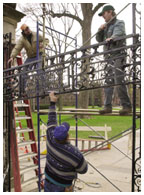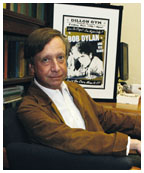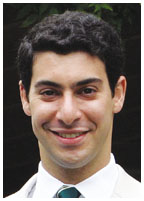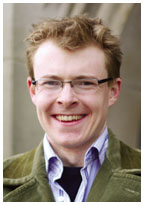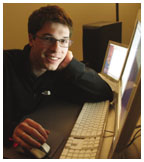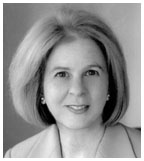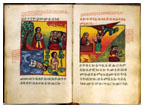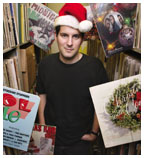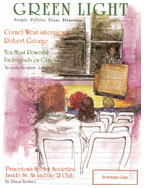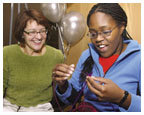January 26, 2005: Notebook
Edwards ’04 looks at life on the campaign trail
Students urge University to invest ethically
Wilentz gets Grammy nomination for Dylan notes
Princeton Project 55 planning to pass torch to younger alumni to spur civic leadership
Values task force calls for more public-service options
Lecture: “Is Manliness Obsolete?”
Princeton conference explores red vs. blue
The Princeton Experience Survey
For Web information, students click on Point
Lecture: "The Da Vinci Code and the Politics of Early Christianity"
Early-admission applications up
New student magazine gets ‘green light’
In briefEdwards ’04 looks at life on the campaign trail
For her senior thesis at Princeton, politics major Cate Edwards ’04 analyzed the primary election process, using her father John’s 2004 candidacy to show how details matter in the dynamic game of politics. Soon after Commencement, the 22-year-old Edwards received an unusual graduate education in presidential politics, returning to the campaign trail to stump for her father when he became the running mate of Democrat John Kerry.
Navigating scores of campaign appearances, from Rock the Vote concerts to student gatherings at college auditoriums, she touted the Democratic ticket and tried to engage young voters in the electoral process. Her audiences were receptive, particularly in recognizing the importance of voting. “A lot of people who sat it out last time didn’t think they could afford to sit it out this time,” she says.
Edwards had moved to New York in July to begin her job as an editorial researcher at Vanity Fair, but before she could unpack her boxes, Kerry selected her father as his vice-presidential candidate. She decided to put the job on hold.
Work on a campaign is a perfect fit for a recent college grad, according to Edwards. “We have energy,” she says, “and we’re used to not sleeping that much.” But with three campaign stops a day, plus interviews, the process proved emotionally, if not physically, draining. Edwards grew more comfortable in the spotlight over time. She learned to field the common questions, such as describing her dad (“he always put his family first, even when he was trying a big case,” she told the Boston Globe), and was equally deft describing her wardrobe for the New York Times Style page (“I like solid basics that I can mix and match”).
To catch up on rest and keep in touch with friends, Edwards spent weekends in New York. But as the election drew closer, she dropped the stopovers in favor of more appearances, particularly in battleground states. “I was pretty much everywhere,” she says, hopscotching from Florida to Wisconsin to Minnesota to Ohio. She spent Election Day with her family in Boston, anxiously awaiting the returns.
By the time Kerry conceded on Nov. 3, the Edwards family had a more urgent personal matter to contend with. Cate’s mother, Elizabeth, had been diagnosed with cancer after detecting a lump in her breast during the final week of the campaign. “I sort of flew by the results [of the election] and had to start thinking about other things immediately,” Edwards says. Her mother began treatment shortly after the diagnosis and has responded well, she says.
In December, with her family fading from the headlines, Edwards began her job behind the scenes in the magazine business. While the election did not conclude the way she had hoped, she remains optimistic about electoral politics. She does not see herself as a future candidate, but plans to remain politically active, inspired by the campaign experience and her father’s influence.
“You get so passionate, and you get so attached to your beliefs,”
she says. “I saw how my dad worked so hard, with such passion, and
saw how he sincerely wanted to help people.” ![]()
By B.T.

Students urge University to invest ethically
At December’s meeting of the Council of the Princeton University Community (CPUC), President Tilghman supported a call to re-evaluate the University’s policy for voting on proxy issues for companies in which the University endowment is invested. Pending the approval of the CPUC executive committee, the issue is expected to be reviewed during the spring semester.
Under guidelines approved in 1997, the CPUC resources committee can advise the University Board of Trustees on a proxy vote if there is sustained interest on campus about a particular social issue, and if the community can “reach a consensus about how the University should respond to the situation.” Ben Shell ’05, president of the recently formed Princeton Coalition Advocating Investor Responsibility (P-CAIR), has encouraged the creation of a separate proxy-voting advisory committee to ensure that the University’s proxy votes reflect its values.
Shell’s interest in socially responsible investing stems from his summer internship at the Washington-based Investor Responsibility Research Center. He came in contact with the Responsible Endowment Coalition, a group of students from more than 30 universities, including Harvard, Yale, and Stanford, that promotes ethical investing in college endowments. “I noticed that our peer institutions either had proxy-voting advisory committees or were dealing with socially responsible investing in some way,” Shell said. “I was kind of curious why there was nothing about Princeton.”
When he returned to campus in the fall, Shell and a group of friends created P-CAIR. The group has discussed investment issues with administrators from the University and the Princeton University Investment Company (Princo), which manages the University endowment. Both audiences have been receptive, Shell said. With help from Robert Durkee ’69, the University’s vice president and secretary, P-CAIR is reviewing how other colleges handle social issues in proxy voting.
Durkee said proxy-voting policies at peer institutions cover a broad spectrum, and deciding what works best for Princeton will require a careful examination. He pointed out that the University holds proxy-voting rights for just 3 to 5 percent of endowment investments. (Most of the endowment is invested by outside managers in the equivalent of mutual funds.) But Durkee said that reviewing the eight-year-old voting policy is worthwhile.
“Over time, a number of our students will become investors or
will go on to careers related to investing,” he said. “It’s
a useful educational contribution to raise these issues.” ![]()
By B.T.

(Photo by Frank Wojciechowski) |
Workers reinstall the FitzRandolph Gate, which was removed in July, in
time for its 100th birthday this year. New and restored parts were hand-forged
using traditional blacksmithing methods and tools. ![]()

Wilentz gets Grammy nomination for Dylan notes
Sean Wilentz, historian and scholar of the American ballad, with Dylan memorabilia. (Denise Applewhite) |
What do former president Bill Clinton, rap star Nelly, and Princeton history professor Sean Wilentz have in common?
Unlikely as it may seem, all three were nominated for Grammy Awards this year. Wilentz was nominated in the category of best album notes, for a 52-page booklet written for the two-CD set, The Bootleg Series, Vol. 6: Bob Dylan Live 1964 — Concert at Philharmonic Hall. (Clinton and Nelly were chosen for best spoken word album and best rap album, respectively.) The awards ceremony will be held in Los Angeles Feb. 13, but Wilentz did not know whether he would attend — it’s on a night he is scheduled to teach. It was a musical year for the Dayton-Stockton Professor of History and director of the Program in American Studies. Earlier in the fall, Wilentz’s latest book, The Rose & the Briar, was published by W.W. Norton & Co. to favorable reviews. The book is a collection of essays about the American ballad that Wilentz edited with noted music critic Greil Marcus, a 2000 Anschutz Fellow and 2002 Old Dominion Fellow at Princeton.
Wilentz was a 13-year-old in the audience at New York’s Philharmonic Hall for Dylan’s all-acoustic performance on Halloween night in 1964. Thus he describes the album notes as an unusual “combination of history and memoirs of my 13-year-old self.” Yet bringing a 41-year-old performance to life also required a historian’s sense of perspective. “Most of the people who buy the album probably weren’t even born in 1964,” he said. “I had to try to convey what that concert was like, but also combine it with the sort of work I do now.”
Growing up in Greenwich Village, where his family owned a bookstore, Wilentz was exposed to music from many directions. In December 1963, in his uncle’s apartment above the store, journalist Al Aronowitz introduced Dylan to the beat poet Allen Ginsberg, who was staying there temporarily. Wilentz did not meet Dylan at the time.
His own youthful music tastes were “all over the map.” Though he enjoyed Dylan and Joan Baez, who were the idols of the hip coffeehouse crowd, Wilentz (who said he plays the guitar himself “after a fashion”) listened to the Beatles, Motown, and the Rolling Stones, as well. “As they used to say on Dick Clark’s American Bandstand, if it had a good beat and you could dance to it, I liked it,” he said.
Wilentz is the historian for Dylan’s Web site, www.bobdylan.com, where his Philharmonic Hall album notes can be found. Wilentz writes in the notes that Dylan was only 23 years old the night he took the stage at Philharmonic Hall, in the tumultuous period following the Kennedy assassination, the murder of three civil-rights workers in Mississippi, and the American arrival of the Beatles. “Dylan’s style and his art were changing, too,” Wilentz continues, “with an accelerating and bewildering swiftness befitting the times.” Though some tried to stereotype Dylan as a free-speech radical, he defied both fans and detractors that evening by mixing familiar folk anthems and previously unrecorded protest songs while sometimes undercutting their seriousness with irreverent or dismissive introductions.
Dylan is also a balladeer whose work is discussed in The Rose & the Briar, which comes with a companion CD and features contributions by Wilentz, Princeton colleagues Joyce Carol Oates and Paul Muldoon, and many others. “We wanted performers, people who understood music, essayists, and historical critics,” Wilentz explained. He and Marcus defined their field of study broadly. “The old hidebound folk definition, that anytime you can identify the author of a song it’s not a ballad, is foolish,” Wilentz said. The editors encouraged their reviewers to consider modern ballads as well as traditional ones, so as not to slight contemporary songwriters such as Randy Newman and Bruce Springsteen.
Beyond those spare instructions, though, Wilentz and Marcus told their writers simply to pick any ballad they wanted “and just run with it.” Thus, Wilentz combed the historical record to unearth the true story behind the teenage murder memorialized in “Delia’s Gone,” Oates wrote a short story about her chosen ballad, “Little Maggie,” and Muldoon wrote a ballad of his own, called “Blackwatertown.”
A reading and performance on campus at the James Stewart Theater in
early December was well attended, and hundreds attended a second reading
a week later at the Society for Ethical Culture in New York. Wilentz,
how-ever, has turned his attention to his next book, on about as un-musical
a topic as one could imagine: a history of American politics, due out
in September. ![]()
By M.B.

Illustrations by Steven Veach
 Dino
dynamics
Dino
dynamics
What killed the dinosaurs? Did a large meteorite crash into Earth and initiate the demise of the planet’s largest creatures? “The theory is attractive,” geology professor Gerta Keller admits in an article published by the Geological Society. But based on her research, it’s not accurate. Some geologists have pointed to the 120-mile-wide Chicxulub subsurface crater, discovered in the early 1990s on the coast of Mexico’s Yucatan peninsula, as the impact site of the meteorite that caused the extinction of dinosaurs at the end of the Cretaceous period. Keller’s analysis of rock layers covering the crater refutes that view, showing that the Chicxulub impact predated the departure of the dinosaurs by about 300,000 years. An alternate hypothesis, Keller writes, is that a combination of massive volcanic activity, multiple meteorite impacts, and major climate changes caused the dinosaurs’ extinction.
A day in the life
Measuring how people use their time and how they experience the activities of their daily lives is valuable for a range of research, from medical studies of stress to evaluations of economic policy. With that in mind, psychology and public affairs professor and Nobel laureate Daniel Kahneman teamed with economics and public-affairs professor Alan Krueger and colleagues from three other universities to create the Day Reconstruction Method (DRM), a system for collecting data that combines time-budget measurement and experience sampling. The method, outlined in the Dec. 3 issue of Science, asks participants to record daily activities in a short diary form and describe their feelings about the experiences.
By encouraging “accurate emotional recall,” the authors write, the DRM may “contribute to an accounting system for the well-being of society.”
 Cold
cases
Cold
cases
In the United States, flu season typically spans December to March, with plenty of fevers, sniffles, and sore throats in between. But why are outbreaks of the viral disease largely relegated to these few cold months? The underlying cause may be very small seasonal changes in the transmission rate of influenza (the number of people infected by one infectious person), according to a study in the Nov. 30 Proceedings of the National Academy of Sciences by ecology and evolutionary biology researcher Jonathan Dushoff *97, professor Simon Levin, Harvard researcher Joshua Plotkin *03, and David Earn of McMaster University. The small changes in transmission rates may be amplified by the dynamics of the interaction between influenza viruses and the immune status of the population, partly because immunity is temporary.
 Mortal
men
Mortal
men
From adolescence to late middle age, women are hospitalized more frequently than men, and their self-assessed health ratings are worse than those of their male counterparts. Why, then, do women have lower mortality rates in each age category? Anne Case *88 and Christina Paxson, both professors of economics and public policy at the Woodrow Wilson School, attempted to resolve this paradox in a recent paper, using data from the U.S. National Health Interview Survey. Their research shows that differences in self-rated health are caused by differences between the distribution of certain health conditions among men and women.
Men suffer from more severe cases of certain conditions, particularly
those associated with smoking, which may account for their higher mortality
rates. ![]()

(Photo by Frank Wojciechowski) |
Athletes wrap holiday gifts as part of the Athletes-in-Action Teams and
Toys program. Varsity and club teams purchased gifts for “adopted”
families, and athletes met Dec. 9 at Frist Campus Center to wrap all the
presents. From left are Catie Draper ’05 (volleyball), Amanda Erickson
’06 (softball), Kim Nakamaru ’06 (lightweight crew), and Emily
Vogelzang ’06 (soccer). ![]()

Princeton Project 55 planning to pass torch to younger alumni to spur civic leadership
As they gear up for their 50th reunion, the founders of Princeton Project 55, the alumni-driven civic-leadership initiative, are preparing to pass the torch to younger Princetonians — enlisting young board members and mounting a capital campaign.
“We are well down the road to turning leadership of the project over to others,” said Peter Milano ’55, a co-founder and past president.
Already, Project 55 has broadened its board, and leaders expect that by May, more than half the board members will be from classes that graduated after 1955. A capital campaign has been halted temporarily so as not to conflict with 1955’s 50th-reunion fund raising, but will begin again in the summer, according to president Charles Bray ’55.
The organization hopes to raise at least several million dollars as a “reserve fund to pick up part of the costs so that younger classes will have an easier time,” Bray said. He noted that the founders were at the peak of their earnings potential and approaching retirement when they established the organization, while the younger leaders have fewer financial resources and shoulder great professional and family demands.
Project 55, now 15 years old, is best known for its Public Interest Program, which places Princeton students and recent graduates with nonprofit, public-interest organizations. Over the years, the group has placed more than 1,100 Princetonians with 350 nonprofit organizations. These alumni represent a large employer pool of future leaders, said managing director Katherine Hande ’02.
Other projects have included a character-education program in use in public and private schools; a collaboration with the University to create the Community-Based Learning Inititiative, in which students connect community experiences with classroom work and research; an effort to eradicate tuberculosis; an alumni network to foster collaboration with like-minded alumni of other universities; a social-venture fund for investment in social entrepreneurs; and a civic-values program (related story on next page).
Within the last few years, the board has been giving younger alumni leadership positions while weighing liaisons with other classes, various structural changes, and even a possible name change to attract members of other classes — a proposal that was soundly rejected by younger alumni, who identified with the group’s existing name and mission.
For the 50th reunion, Project 55 plans an open house at its Stockton Street headquarters and a panel session at which former fellows will discuss their experiences.
“They have been incredibly intentional and thoughtful about this process,” said Elizabeth Perriello-Rice ’90, who joined the board three years ago. “The transition process is absolutely going very well — they started early and they are going about it in the best possible way.”
Bray said he was certain that the new, younger leaders would bring an increased sense of “rigor and vigor.”
“The one thing we have learned in this process of creating our
own succession is that there is a significant number of Princetonians,
of every generation, who care about the public good and are willing to
make an investment in it of their own time and energy,” said Bray,
whose term expires in May. “And that’s a nice statement about
Princeton and its alumni.” ![]()
By Tony Carroll ’66

Values task force calls for more public-service options
The Student Task Force on Civic Values is calling for greater efforts to expand, streamline, and coordinate civic-activism efforts on campus, to better prepare students for lives of “active citizenship.”
The 57-page report, which was presented last fall, culminates more than a year of work by seven undergraduates, according to Andrew Frederick ’07, a task force member. The report states that the task force hoped to “provide a road map to focus progress” toward several goals, including preparing students for leadership, identifying resources and needs in the Princeton region, and attracting new generations of civically engaged students.
Among the specific recommendations were calls to establish a public-service summer internship program; work with other American universities to create a domestic counterpart to semester-abroad programs; create a permanent University office in Trenton to tie Princeton to the needs of that community; publish a directory of all academic, service, and advocacy groups on campus; expand the annual Community Fair into a “Community Service and Civic-Engagement Fair” to introduce freshmen to opportunities for public service; and establish a Community Research Fellows Initiative that would enable faculty to conduct research in the community and then create academic courses around their projects.
“An infusion of civic values into academic life at Princeton will result in increased intellectual vigor, and will enrich the undergraduate experience in ways that will remain with students long after graduation, regardless of their career paths,” the report states.
In researching the report, the students interviewed faculty and administrators at Princeton and studied civic-engagement programs at six other northeastern universities. The task force was sponsored by Princeton Project 55, the Pace Center for Community Service, and the Woodrow Wilson School.
The next step, Frederick said, is to create a permanent successor task
force to help implement the recommendations. A copy of the report is online
at www.princeton.edu/%7Estorbert/STFCV.
![]() By M.B.
By M.B.

(Jon Chase/Harvard News Office) |
“We now presuppose, more or less, that men and women are exchangeable, interchangeable. Are we forgetting how they are complementary? According to the feminists, any traditional notion that the sexes complement each other serves merely to justify the inferiority of women.”
Harvard professor of government Harvey Mansfield addressing gender differences
in his Dec. 8 lecture, “Is Manliness Obsolete?” The concept
of manliness, Mansfield said, is not dead, and both men and women can
preserve its positive qualities. ![]()

Joshua Geltzer ’05 (Denise Applewhite)
Patrick Cunningham ’05 (Jon Jameson ’04) |
Seniors Joshua Geltzer and Patrick Cunningham have won Marshall scholarships, which provide two years of study at any British university.
Geltzer, from New York City, is concentrating in the Woodrow Wilson School and plans to study Anglo-American foreign policy while pursuing his master’s degree at either King’s College in London or at Oxford University. He shared the Class of 1939 Princeton Scholar Award, which is given to the junior with the highest academic standing, twice won the Shapiro Prize for Academic Excellence, and won the Haarlow Prize for Best Paper in Humanistic Studies.
Cunningham, an English major from Stow, Ohio, plans to study comedic
writing from the late Victorian period while pursuing his master’s
degree at Oxford. The editor of Tiger Magazine and the Nassau
Weekly, as well as a member of the Honor Committee, Cunningham has
won the creative writing program’s award for outstanding writing
in each of his first three years, and earned the A. Scott Berg ’71
Scholarship from the English department. He is a stand-up comedian and
creative director of a software design firm. ![]()

Princeton conference explores red vs. blue
After two close, bitter national elections, are we, the American people, really as uncompromisingly “red” or “blue” as the pundits would have us believe? Or are we actually some blend of the two — “We the Purple,” if you will — and far more moderate?
Those questions were the starting point for a conference held Dec. 3 and 4 at the Woodrow Wilson School. Titled “The Polarization of American Politics: Myth or Reality?” it brought together prominent students of public opinion, current and former members of Congress, and journalists including David Broder of the Washington Post and Jonathan Alter of Newsweek.
Some argued that our present level of polarization is not unprecedented. What makes it feel so extreme, said David Brady of the Hoover Institution at Stanford University, is that we are experiencing it on the heels of what really was an unusual period in our history, the 20 years of Cold War consensus that followed World War II.
Still, a parade of graphs and colored maps was produced to show that something is afoot. Americans are segregating themselves into increasingly like-minded enclaves, a migration spurred on by a polarizing media and reinforced by creative gerrymandering. Thus Republican counties now tend to be rural, while Democratic ones are more likely to be urban and more populous. As late as 1980, Democratic and Republican counties averaged the same number of voters.
Congress, too, is more divided along ideological lines. Conservative Democrats once joined with liberal Republicans to form a moderate block that wielded real power; today, there is virtually no overlap. Party leaders demand absolute loyalty from members and frown upon fraternization across party lines. According to John Pitney of Claremont McKenna College, a strategy of “sack the quarterback” dominates Washington, with Tom Daschle merely the latest in a line of “sacked quarterbacks” stretching back through Trent Lott to Newt Gingrich and Jim Wright.
This has serious consequences. When members feel more loyalty to their party than to the institution of Congress, it undermines a system predicated on checks and balances. “There has been a great deal of abdication of the separation of powers that has diminished the Congress and, in doing so, has somewhat betrayed the American people, who count on the Congress to act as a check on the executive branch,” said Mickey Edwards, the former Republican congressman who now teaches at the Woodrow Wilson School.
Tom Cole, a Republican congressman from Oklahoma, argued that the defection
of moderate southern Democrats to the Republican Party in response to
the civil rights movement is part of a broader “sorting out”
into more clearly defined ideological camps. “One difference is
the ferocity of the team mentality, at least on the Republican side,”
acknowledged Cole. “Most on the Republican side have spent most
of their career in the minority. They don’t intend to go back.”
![]()
Which, many participants agreed, means polarization for some time to come.
By Merrell Noden ’78

The Princeton Experience Survey, published in November, invited more than 2,500 students to answer questions about their comfort, likes, and dislikes at the University. About 75 percent replied.
Asked what they liked most, undergraduates most frequently chose the academic experience, the people, and the sense of community. The social atmosphere and academic issues, such as workload and distribution requirements, topped the list of what students liked least. Graduate students said the faculty and intellectual community were the highlights of their Princeton experience, with housing and social life as the downsides. Some results suggest a racial disparity — for example, 17 percent of African-American undergraduates described their comfort level as “not good,” compared to 3 percent of white undergraduates.
The survey is online at http://www.princeton.edu/~provost/research_
pu_info.html. ![]()

Source: The Summary Report of the Princeton Experience Survey (Office of the Provost)
(Illustration: Steven Veach)

For Web information, students click on Point
Clay Bavor ’05 and three computer-science colleagues designed the Point.Princeton.edu site, an interactive Web portal for students that highlights event listings. (Frank Wojciechowski) |
From the desktop computer in his dormitory room, University Student Government webmaster Clay Bavor ’05 can monitor the number of visitors on Point.Princeton.edu, the USG Web portal launched in November. About 1,000 students check the site each day, three-quarters of all undergraduates have logged on at least once, and total hits in the site’s first month topped 200,000. But Bavor hopes the numbers that really matter will be visible at lecture halls and student gatherings, when students who use listings on the site find events that fit their interests.
The Point portal displays handy information, such as Dinky schedules, weather, and daily news, and the central portion of the site is devoted to events, providing a student-driven alternative to other campus calendars. According to USG president Matt Margolin ’05, who went to high school with Bavor in California, many student groups rely on word of mouth or posters to publicize lectures or performances. “You see lampposts bombarded with sheets of 81/2-by-11 paper, competing to get the word out,” he said. With Point’s calendar, Margolin hopes that groups will be able to reach interested students more effectively.
All events on the calendar are submitted by students, faculty, or staff, and they are rated on a scale of one to five stars, based on the number of visitors who click on them. Only one click per user counts in the ratings, so students cannot stuff the ballot box, and users with an interest in a specific category, such as theater or lectures, can set preferences to highlight events they might enjoy.
Point also offers interactive features, enabling students to rate and review local restaurants or vote in daily poll questions, which are submitted by students. The poll has been the site’s most popular feature, with questions ranging from “Should the University designate all undergraduate housing smoke-free?” (63 percent said yes) to “Are you dating anyone?” (54 percent said no, 9 percent weren’t sure).
The evolution of the Point site began with Find.Princeton.edu, an eating club social-events site purchased by USG when its webmaster graduated. Bavor rewrote the code and redesigned the portal, with help from fellow computer science students Jamie Niemasik ’06, David Kaplan ’06, and Darsh Ranjan ’05. “We wanted it to be streamlined, easy to use, and well organized,” Bavor said. “In addition to being user-friendly, it’s also easy to add to the site.”
Bavor and his colleagues completed the site and worked out security and liability issues in seven months, including summer vacation. Bavor has plans for additional features (an e-Bay-style auction function, a natural language query where students can find answers to campus questions), but according to Margolin, the site has already achieved its initial goal, providing a Web portal for students, driven by students.
“Students recognized a specific problem or need and actually came
up with the answer,” Margolin said. “How often does that happen?”
![]()
By B.T.

(Photo:Office of Communications) |
“The question about whether women can participate in the religious movement is not a 20th-century question, but a question from back in the time when Mary Magdalene was written out of the Gospels.”
Elaine Pagels, the Harrington Spear Paine Foundation Professor of Religion,
at a Dec. 1 discussion with politics professor Paul Sigmund titled “The
Da Vinci Code and the Politics of Early Christianity.” Pagels is
the author of Beyond Belief: The Secret Gospel of Thomas.
![]()

(PAUM) |
“Songs, Psalms, and Praises: An Eighteenth-Century Ethiopian Manuscript” continues on view at the Art Museum through June 5. The 18th-century manuscript consists of 119 vellum pages with 109 vibrant, miniature illuminations. The manuscript, written in Ge’ez, the ancient liturgical language of Ethiopia, contains songs of the prophets, praises of Mary, psalms, and prayers. In addition to portrayals of Mary and Biblical stories, the images in the manuscript illustrate various aspects of
18th-century Ethiopian life, including dress, churches and other buildings, household objects, and weapons. Curators believe that this manuscript was produced in a royal scriptorium in Gondar, the Ethiopian capital established in the 16th century, which became a center of artistic production. For information, contact the Art Museum at (609) 258-3788.
“Bush’s Second Term: A Panel Discussion on What to Expect” is the topic of a Woodrow Wilson School program at 4:30 p.m. Monday, Feb. 7, in Bowl 016 in Robertson Hall. Participants include Michael McCurry ’76, who served President Bill Clinton as White House press secretary from 1995 to 1998; David Lewis, assistant professor of politics and public affairs; Fred Greenstein, professor of politics, emeritus, who is known for his scholarship on presidential leadership styles; and Larry Bartels, professor of politics and public and international affairs.
The James Madison Program in American Ideals and Institutions will sponsor a lecture by Nelson Lund, the Patrick Henry Professor of Constitutional Law and the Second Amendment at the George Mason University School of Law, titled “Lawrence v. Texas: The Worst Supreme Court Decision in History?” on Monday, Feb. 7, from 4:30 to
6 p.m. in Computer Science 104. The lecture title refers to the U.S.
Supreme Court’s 2003 decision striking down anti-sodomy laws as
unconstitutional. The lecture is free and open to the public.![]()

WPRB DJ Jon Solomon has played Christmas tunes for 24 hours straight each year for 17 years. (Photo by Frank Wojciechowski) |
For the 17th year, listeners who wanted a break from the typical Christmas music overwhelming the airwaves were able to find it for 24 hours straight on Princeton’s student-run radio station, WPRB. Jon Solomon, who manned the booth alone from 6 p.m. on Christmas Eve to 6 p.m. on Christmas Day, first did his marathon holiday show in 1988 as a 15-year-old trainee broadcaster. He began at 7 p.m. and thought he would stay on the air until the next DJ came on duty. But the next DJ never came, and the following morning Solomon was still going.
Although the campus is usually deserted, Solomon, a Northwestern alum who grew up in Princeton, says he receives a few visits each year from local fans and many more e-mails from those listening on the radio or on the Internet, one from as far away as Egypt. If it were Top 40, of course, it wouldn’t be ’PRB, so Solomon spins an eclectic mix ranging from Sammy Davis Jr.’s “Jingle Bell Rock” to the Drive-By-Truckers’ “Hope Santa’s Out of Rehab for Christmas.” He begins preparing for this show a month ahead of time, compiling a folder on his iPod that includes many tracks sent to him by fans.
“The fact that 17 years in, the show continues to mean a lot to
people is humbling,” says Solomon, who also runs an independent
record company and www.princetonbasketball.com,
a Web site with news of Tigers basketball. “People who started listening
to me when I began now listen to it with their families.” ![]()
By M.B.

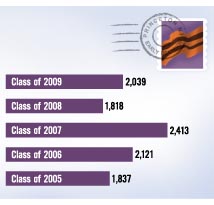 Early-admission
applications up
Early-admission
applications up
After a sharp decline in 2003, applications to Princeton’s early-decision
program rebounded in 2004, increasing by 12 percent. In December, the
University admitted 593 early applicants (55 percent male, 45 percent
female), who are expected to make up 49 percent of the Class of 2009.
Regular-decision applicants will be admitted in April.
![]()

Prototype cover for Green Light magazine, which will debut in February. |
New student magazine gets ‘green light’
A new, quarterly student publication known as Green Light will make its campus debut next month. Blending cultural commentary, reviews, and investigative reporting, the magazine’s audacious goal is to become nothing less than Princeton’s version of The New Yorker.
“We want to blend articles from faculty, students, and alumni so the magazine really becomes a forum for dialogue in the community,” said Andrew Perlmutter ’06, the magazine’s co-founder, with Jeff Miller ’06.
The magazine draws its name from the green light at the end of Daisy Buchanan’s dock that enticed Jay Gatsby in F. Scott Fitzgerald ’17’s The Great Gatsby. “We wanted something semi-literary, yet strong,” Perlmutter explained. “We thought the name ‘Green Light’ was a nice way of referencing back to Princeton and reflected Gatsby’s idealism, as well.”
Religion professor Cornel West *80 will headline Green Light’s
inaugural issue with an interview of his colleague, Robert P. George,
the McCormick Professor of Jurisprudence. A la The New Yorker,
the magazine will include non-fiction, fiction, poetry, and artwork, including
cartoons. With financial support from the Council of the Humanities and
some alumni, the magazine has an initial run of 10,000 copies. Perlmutter
said he plans to distribute the magazine free to all students and faculty
and, at first, to three to four thousand alumni. ![]()
By M.B.

(Photo by Frank Wojciechowski) |
Paris Makell ’04, right, works under the guidance of Robin Nissenfeld,
a knitting instructor at Pins and Needles, a Princeton knitting shop.
They were participating in a “community knitting project”
that was held as part of the Frist Campus Center’s Winter Holiday
Festival. Participants knitted children’s scarves and hats to be
donated to local charities. ![]()

Two Princetonians competed for fame and fortune on national television recently, though neither got the big prize.
Jennifer Massey ’96 failed to get a job on real-estate mogul Donald Trump’s payroll, losing to software executive Kelly Perdew during the season finale of The Apprentice Dec. 16. In the final contest, in which Massey and Perdew had to manage charity events, Massey put together a basketball game with NBA stars, while Perdew, a West Point graduate, organized a polo match. Later, about 16.9 million viewers watched as Massey heard Trump utter the dreaded words: “You’re fired!”
Susan McWilliams, a graduate student in the politics department, appeared on Who Wants to Be a Millionaire? earlier in the month, winning $50,000. She successfully answered seven questions before being stumped on the $100,000 question: “Before marrying him, what wife of Henry VIII served as a lady-in-waiting to two of his previous wives?” Answer: Jane Seymour.
A bill passed by the New Jersey Legislature Dec. 13 would prevent buildings such as Princeton’s famed eating clubs from becoming tax-exempt property. Known as the “Cottage Bill,” after University Cottage Club, the legislation tightens the qualifications under which privately owned historic buildings could become tax-exempt. Such a building would have to be open to the public for 96 days each year unless it received a waiver.
Cottage Club had applied to the state Department of Environmental Protection for tax-exempt status because the building is included on the state and federal registers of historic places. The application was denied, and the club is appealing to the Appellate Division of the state Superior Court.
The “Cottage Bill” was signed into law Dec. 22 by Acting Gov. Richard J. Codey, and it took effect the same day.
Lynn Enquist, chairman of the molecular biology department,
has received a Sen. Jacob Javits Award, which provides up to seven years
of research funding from the National Institute of Neurological Disorders
and Stroke. He was among eight researchers to win the award, which honors
“exceptional scientific excellence and productivity” in research
related to the brain and nervous system. ![]()


